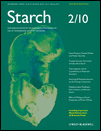Polyelectrolyte Multilayers from Cationic and Anionic Starch: Influence of Charge Density and Salt Concentration on the Properties of the Adsorbed Layers
Abstract
The purpose of the present work was for identify limits for the formation of stable polyelectrolyte multilayers (PEMs) from cationic and anionic starches (with degrees of substitution of 0.04–0.09) on SiO2 surfaces, taking account of the effect of the charge density of the starches and the salt concentration in the surrounding water phase. The experiments were performed at a pH of 6.3 using stagnation point adsorption reflectometry (SPAR) and quartz crystal microbalance with dissipation (QCM-D). From these experiments it was concluded that it is possible to form PEMs by the adsorption of oppositely charged starches on SiO2 surfaces; it was also found that adsorption of the first layer is controlled both by electrostatic, non-ionic interactions and by pure steric restrictions, i.e. geometrical restrictions, at the surface. The results also indicate that the charge density of the starch must exceed a certain value to allow multilayer formation and that this critical charge density increases with increasing salt concentration. The combination of charge densities of the cationic/anionic starches was also found to influence the adsorption behaviour, and the formed polyelectrolyte multilayers had a high water content of 69–92%.




